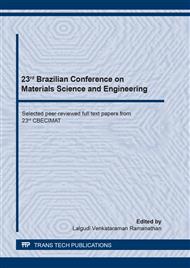[1]
P.K. Singh, A.L. Kumar, P.K. Katiyar, R. Maurya: Journal of Materials Research and Technology Vol. 6 (2017), p.289.
Google Scholar
[2]
J. Rosales, M. Cabrera, F. Agrela: Construction and Building Materials Vol. 142 (2017),p.444.
Google Scholar
[3]
C.M.F. Vieira, C.A.C.M. Dias, A.V. Mothé, R. Sánchez, S.N. Monteiro: Ceramic Vol. 53 (2007), p.381.
Google Scholar
[4]
X. Yu, Z. Tao, T. Song, Z. Pan: Construction and Building Materials Vol. 114 (2016), p.737.
Google Scholar
[5]
L.V. Fisher, A.R. Barron: Resources, Conservation and Recycling Vol. 146 (2019), p.244.
Google Scholar
[6]
Brazil Steel Institute. Market numbers / Statistics. Available at: http://www.acobrasil.org.br/site/arquivos/estatisticas/Preliminar_Junho_2017.pdf. Accessed on: July 4, (2017).
Google Scholar
[7]
M. Oge, D. Ozkan, M.B. Celik, M.S. Gok, A.C. Karaoglanli: Materials Today: Proceedings Vol. 11 (2019), p.516.
DOI: 10.1016/j.matpr.2019.01.023
Google Scholar
[8]
M.M. Ribeiro, C.M.F. Vieira, S.N. Monteiro: 54° Congresso Brasileiro de Cerâmica (CBC). Foz do Iguaçu, 30 Maio-02 de Junho 2010. Proceeding...Foz do Iguaçu 2010. (PR) [9] M.M. Ribeiro, E.S. Lima, A.B.S. Figueiredo, L.F. Amaral, S.N. Monteiro, C.M.F. Vieira: Journal of Materials Research and Technology Vol. 7 (4) (2018), p.612.
DOI: 10.28933/ajprr-2021-07-1005
Google Scholar
[10]
C.M.F. Vieira, L.F. Amaral, S.N. Monteiro: Mansoor Zoveidavianpoor, IntechOpen (2018), p.25.
Google Scholar
[11]
A.C. Camargo, J.C.S. Portela, H.N. Yoshimura: Industrial Ceramics Vol. 10 (2005), p.39.
Google Scholar
[12]
H.N. Yoshimura, A.C. Camargo, J.C.S. Portela: Industrial Ceramics Vol. (2005), p.35.
Google Scholar
[13]
R.E. Grim: Americam Ceramic Society Bulletin Vol. 44 (1965), p.687.
Google Scholar
[14]
P.S. Santos: Clay Science and Technology. (Edgard Blucher, vol. 2 São Paulo, 1989).
Google Scholar
[15]
C.M.F. Vieira, S.N. Monteiro: Materials Science Forum Vols. 727-728 (2012), p.959.
Google Scholar
[16]
Brazilian Association of Technical Norms. Sampling of Solid waste. Rio de Janeiro: ABNT (2004). (NBR – 10004) (In Portuguese).
Google Scholar
[17]
Brazilian Association of Technical Norms –Procedure for obtaining leach extract from solid wastes. Rio de Janeiro: ABNT (2004). (NBR 10005). (In Portuguese).
Google Scholar
[18]
Brazilian Association of Technical Norms. Procedure for Obtaining Solubilized Solid Waste Extract. Rio de Janeiro: ABNT (2004). (NBR 10006) (In Portuguese).
Google Scholar
[19]
M.F. Abajo: Manual Sobre Fabricación de Baldosas, Tejas y Ladrillos, Beralmar, Espanha.
Google Scholar
[20]
A.G. Verduch, V.S. Solana: Industrial Ceramics Vol. 5 (2000), p.38.
Google Scholar
[21]
Brazilian Association for Technical Norms. Ceramic components Part 1: Hollow ceramic blocks for non-load-bearing masonry – Terminology and requirements. Rio de Janeiro: ABNT 2017. (NBR 15270-1).
Google Scholar


